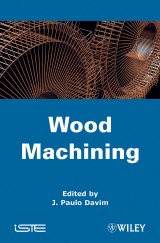Details

Wood Machining
1. Aufl.
|
CHF 76.00 |
|
| Verlag: | Wiley |
| Format: | |
| Veröffentl.: | 07.02.2013 |
| ISBN/EAN: | 9781118602300 |
| Sprache: | englisch |
| Anzahl Seiten: | 288 |
DRM-geschütztes eBook, Sie benötigen z.B. Adobe Digital Editions und eine Adobe ID zum Lesen.
Beschreibungen
Wood as an engineering material can be technically defined “as a hygroscopic, orthotropic, biological, and permeable material having extreme chemical diversity and physical complexity with structures, that vary extensively in their shape, size, properties and function”. Therefore, using wood to its best advantage and most efficiency in engineering applications, specific characteristics or chemical, physical and mechanical properties must be considered.<br /> The products are divided into two classes, solid wood and composite wood products. Solid wood includes shipbuilding, bridges, flooring, mine timbers, etc. Composite wood products include insulation board, plywood, oriented strand board, hardboard and particle board.<br /> In recent years, the machining of wood products has acquired great importance due the short supply of wood and increasing environmental awareness among users and manufacturers. The optimization of the machining process centers around the mechanism of chip formation, tool wear, workpiece surface quality, crack initiation and propagation of different types of wood. Other factors are also humidity, temperature, static preloads, and vibrations that can affect the wood during the machining process.<br /> The book provides some fundamentals and recent research advances on machining wood and wood products.
<p><b>Preface xi</b></p> <p><b>Chapter 1. Machining of Wood and Wood Composites 1</b><br /> <i>Grzegorz KOWALUK</i></p> <p>1.1. Introduction 1</p> <p>1.2. Wood and wood-based composites 2</p> <p>1.3. Approach to cutting 7</p> <p>1.4. Main techniques of machining 11</p> <p>1.5. Problems of machining wood and wood composites – a review 19</p> <p>1.6. Into the future – further scenarios of wood and wood composites machining 21</p> <p>1.7. Acknowledgement 23</p> <p>1.8. Bibliography 24</p> <p><b>Chapter 2. Wood and Wood-based Panel Machining Quality 27</b><br /> <i>Cristina COELHO, Nuno GARRIDO, Jorge MARTINS, Luisa CARVALHO and Carlos COSTA</i></p> <p>2.1. Solid wood machining 27</p> <p>2.2. Wood-based panels machining 39</p> <p>2.3. Surface quality 50</p> <p>2.4. Case study: solid wood machining and surface quality evaluation 65</p> <p>2.5. Case study: particleboard machining and edge quality evaluation 73</p> <p>2.6. Bibliography 75</p> <p><b>Chapter 3. Reducing Tool Wear by Cryogenic Treatment and Cooling with Refrigerated Air when Processing Medium Density Fiberboard 83</b><br /> <i>Rado GAZO, Judith GISIP and Harold A. STEWART</i></p> <p>3.1. Introduction 83</p> <p>3.2. Effects of refrigerated air 85</p> <p>3.3. Effects of cryogenic treatment and refrigerated air 98</p> <p>3.4. Acknowledgements 111</p> <p>3.5. Bibliography 111</p> <p><b>Chapter 4. Wearing Mechanisms Contributing to Reduced Tool Life after Wood and Secondary</b><br /> <b>Wood Products Machining 115</b><br /> <i>Boles³aw PORANKIEWICZ</i></p> <p>4.1. Introduction 116</p> <p>4.2. Cutting edge-material cut interface 116</p> <p>4.3. TGA indirect evidence of HTTR 119</p> <p>4.4. Theoretical QC analysis of HTTR 134</p> <p>4.5. Investigations of direct evidence of HTTR 140</p> <p>4.6. Cutting edge SEM image examinations 143</p> <p>4.7. Synergistic effect of high temperature reactions and mechanical wear 146</p> <p>4.8. Final remarks 150</p> <p>4.9. Conclusions 154</p> <p>4.10. Acknowledgements 155</p> <p>4.11. Bibliography 155</p> <p><b>Chapter 5. Monitoring Surface Quality on Molding and Sawing Processes for Solid Wood and Wood Panels 159</b><br /> <i>Alfredo AGUILERA</i></p> <p>5.1. Introduction 159</p> <p>5.2. General concepts 160</p> <p>5.3. Monitoring the cutting process 176</p> <p>5.4. Surface roughness and quality for solid wood and panels 190</p> <p>5.5. Concluding remarks 210</p> <p>5.6. Acknowledgements 211</p> <p>5.7. Bibliography 211</p> <p><b>Chapter 6. Evaluating the Roughness of Sanded Wood Surfaces 217</b><br /> <i>Lidia GURAU, Hugh MANSFIELD-WILLIAMS and Mark IRLE</i></p> <p>6.1. Introduction 217</p> <p>6.2. Profile filtering applied to wood surfaces 228</p> <p>6.3. A proposed method for separating processing roughness from anatomical roughness 246</p> <p>6.4. A case study: the processing roughness of oak surfaces sanded with various grit sizes 250</p> <p>6.5. Concluding remarks 259</p> <p>6.6. Perspectives 260</p> <p>6.7. Acknowledgements 261</p> <p>6.8. Bibliography 261</p> <p>List of Authors 269</p> <p>Index 273</p>
"This book should be valuable in advanced courses for undergraduate engineering students in courses dealing with wood machining. It might also serve as a reference for researchers inside the field of wood mechanics and wood manufacturing." (International Wood Products Journal, 1 April 2011)<br /> <br /> <p> </p>
<p><strong>J. Paulo Davim</strong> is an aggregate professor of the Department of Mechanical Engineering at the University of Aveiro in Portugal.

















